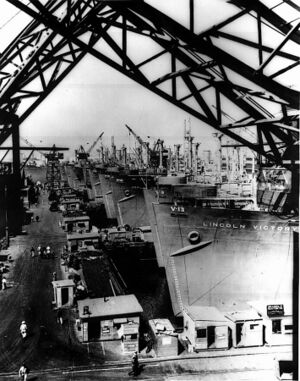Engineering:SS Lincoln Victory
 SS Lincoln Victory and other Victory ships at a U.S. west coast shipyard Calship yard, Wilmington, California in 1944.
| |
| History | |
|---|---|
| Name: | SS Lincoln Victory |
| Namesake: | Lincoln, Nebraska-Abraham Lincoln |
| Owner: | War Shipping Administration |
| Operator: | Eastern SS Lines |
| Builder: | California Shipbuilding Company, Los Angeles |
| Laid down: | February 26, 1944 |
| Launched: | April 27, 1944 |
| Completed: | June 15, 1944 |
| Fate: | Sold to the Netherlands, 1947 |
| Name: | SS Aardijk |
| Operator: | Holland America Line |
| Renamed: | SS Aardyk, 1954 |
| Fate: | Sold to Taiwan, 1962 |
| Name: | SS Sian Yung |
| Owner: | Chinese Maritime Trust Company |
| Fate: | Partially sunk and abandoned, 6 December 1970; refloated and scuttled in deeper waters, 11 January 1972 |
| General characteristics | |
| Class and type: | VC2-S-AP3 Victory ship |
| Tonnage: | 7612 GRT, 4,553 NRT |
| Displacement: | 15,200 tons |
| Length: | 455 ft (139 m) |
| Beam: | 62 ft (19 m) |
| Draft: | 28 ft (8.5 m) |
| Installed power: | 8,500 shp (6,300 kW) |
| Propulsion: | HP & LP turbines geared to a single 20.5-foot (6.2 m) propeller |
| Speed: | 16.5 knots |
| Boats & landing craft carried: | 4 Lifeboats |
| Complement: | 62 Merchant Marine and 28 US Naval Armed Guards |
| Armament: |
|
| Notes: | [1] |
The SS Lincoln Victory was a Victory ship built during World War II under the Emergency Shipbuilding program. She was built by the California Shipbuilding Company, launched on April 27, 1944 and completed on June 15, 1944. The ship’s United States Maritime Commission designation was VC2-S-AP3, hull number 13 (V13); she was initially operated by the Eastern SS Lines as a United States Merchant Marine ship.
World War II
The SS Lincoln Victory served in the Atlantic Ocean during World War II. SS Lincoln Victory, along with 96 other Victory ships, were converted to troopships to bring the US soldiers home as part of Operation Magic Carpet. She departed the so-called Cigarette Camps in Europe to bring troops home. She had two notable Atlantic crossings. On Dec. 17, 1945, she steamed out of Le Havre, France with 1,535 troops arriving in Boston on Dec. 27, 1945. In this trip, she carried the 93rd quartermaster railroad company, the 3914th quartermaster gas supply company, and the 783rd railway shop battalion and transportation corps. In February 1946, she departed from Bremerhaven, Germany , returning soldiers to Camp Kilmer, New Jersey.[2][3][4][5][6]
Private use
After the war, on May 27, 1947, the Lincoln Victory was sold to the Dutch government's Nederlandsch-Amerikaansche Stoomvaart-Maatschappij, that later became the Holland America who renamed her the SS Aardijk. She began her second maiden voyage on July 23, 1947 from Rotterdam to Cuba, Mexico and then New Orleans. In 1954, she was renamed the SS Aardyk by the Holland America Line.[7][8][9][10]
In 1962, she was sold to the Chinese Maritime Trust Company in Taiwan and renamed the SS Sian Yung. On December 6, 1970, while southbound on a voyage from the Panama Canal to the Far East with a cargo of rice, baled cotton, and 200 barrels of heavy fuel oil, the Sian Yung was damaged after hitting rocks at the Gaillard Cut. To stop her from sinking in the Canal, she was run aground near the Pedro Miguel locks. Several salvage attempts were made, but all initially failed. In 1972, her cargo and entire superstructure was removed so the Ajax and Hercules cranes could raise her, allowing workers to patch her, pump out water, and move her to the Bay of Panama. She was half sunk on Jan. 11, 1972 into her final resting place along the shore, south of Balboa, Panama at 7°44N 79°21W.[11][12][13][14] The owner of the Sian Yung abandoned the ship to its insurance underwriter. A court case on April 30, 1973 decided the cost of the loss.[15][16][17]
See also
- List of Victory ships
- Liberty ship
- Type C1 ship
- Type C2 ship
- Type C3 ship
References
- ↑ Babcock & Wilcox (April 1944). "Victory Ships". Marine Engineering and Shipping Review.
- ↑ ww2troopships.com crossings in 1945
- ↑ Troop Ship of World War II, April 1947, Page 356-357
- ↑ 69th infantry division, newsletter, 1986
- ↑ The Nebraska State Journal from Lincoln, Nebraska, December 26, 1945, Page 4
- ↑ Binghamton NY Press Grayscale 1945 - Fulton History, Oct. 15, 1945
- ↑ Holland America Line ship list
- ↑ SS Aardijk, Holland-Amerika Lijn, 1947
- ↑ HAL postcards
- ↑ Holland-America Line, S.S Aardyk (1947)
- ↑ The Sian Yung, by: Charles W. Hummer, Jr., BHS '55
- ↑ Sian Yung Sinks in the Canal by C. W. “Chuck” Hummer, Jr.
- ↑ Sian Yung sunk in the Culebra Cut
- ↑ www.shipspotting.com, Sunk Sian Yung
- ↑ openjurist.org, Chinese Maritime Trust Ltd Steamship Sian Yung Republic of Vietnam v. April 30, 1973
- ↑ Wrecksite Aardijk SS (1947~1954) Sian Yung SS (+1972)
- ↑ alpostcards.com, Aardijk
Sources
- Sawyer, L.A. and W.H. Mitchell. Victory ships and tankers: The history of the ‘Victory’ type cargo ships and of the tankers built in the United States of America during World War II, Cornell Maritime Press, 1974, 0-87033-182-5.
- United States Maritime Commission: [1]
- Victory Cargo Ships [2]
 |

